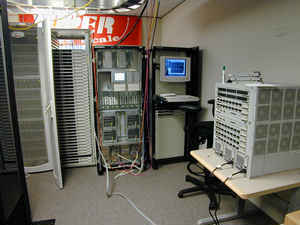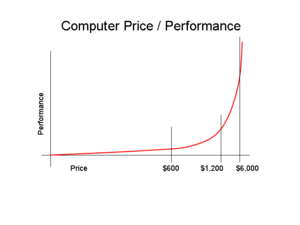Some thoughts on buying a personal computer...
Reflecting on the previous post about the guy who bought the "biggest and bestest" machine he could afford, here are a few of my thoughts regarding buying a computer.
There are some instances where the "biggest and bestest" is justified. When I was working for MSFT, we had a few of these in our lab including this beauty:

The two cabinets on the right comprise a mainframe system that runs Windows. It is a Unisys ES-7000. 32 Xeon processors, 128 PCI slots, gobs of RAM and disk space. The cabinet on the right is just the control unit, #3 from the left is the CPU. #2 from the left is 35 or so Compaq 1U "pizza box" computers acting as load and #1 from the left is a fibre channel disk array.
The ES-7000 is perfect for a large business.
It costs over $2 Million.
The ES-7000 would be absolutely lousy for a home computer (even if you could get the three sets of 60 Amp 240 Volt electrical power to feed it). It took about 20 minutes to boot (and it was working hard!), it doesn't run video cards well (which CPU, what memory) and it doesn't even have a keyboard or mouse (all control is done through the #4 cabinet) but for pure exhilarating balls-to-the-wall server performance, it rocks! If you are Target or Barnes and Noble, you have several of these boxes sitting on the fattest internet pipe you can afford.
For home computing, you need to look at it as a tool that you will use 10-20 hours/week. You need to consider a few things:
- Having a computer greatly aids your work.
- Computer performance doubles every 18 months (Moore's Law)
- Newer software will not run reliably on older systems.
And on to my thoughts.
What I look at is the price/performance curve. If you do not need absolute performance, if you are doing basic office stuff, some art, some music, some creative stuff but the bleeding edge $6K systems aren't something for you, take a look at this graph:

Click for full-size Image
Obviously, if you are cheap, you will not get any real performance. There are some basic costs for the sheet metal and the monitor, hard disk, etc... You are not buying any performance.
Where you want to be is at the knee to the right. There, you get a significant gain in performance without paying the penalty for being on the bleeding edge.
These days, this knee is right around $1,000 to $1,400. At this point, you will get a good solid system that will give you adequate performance for two years. If you use it for 20 hours/week, this works out to about a fifty cents an hour for the machine and after you are done, you still have a useful machine to donate to a non-profit or to sell for $200 or so or to give to someone who doesn't have a computer (go ahead, make their day!).
The key thing is not to buy the absolute best unless you have a legitimate need and then to understand that you will need to feed that need several times/year as improvements come out.
If you do not have the legitimate need, if you just need a basic decent system, plan on spending about $1,000 to $1,400 every two years.
This "knee" point used to be around $2,500 so things keep improving. It will probably drop to around $700 to $1,000 by December of this year.
A final thought. Retail markup is about 100% over wholesale in all but a few business. Computers is one of these. Markups used to be decent and when I had my first computer store, I made some decent money and sold some good computers to people at honest prices.
These days are long gone -- the average markup now is less than 15%.
What this means to you as the consumer is that if someone is offering a system that looks good but is priced significantly lower than the other systems you are looking at, there is probably a very very good reason for this. Avoid these people like the plague.
When buying a computer, you do get what you pay for.
Posted by DaveH at February 26, 2006 10:17 PM

